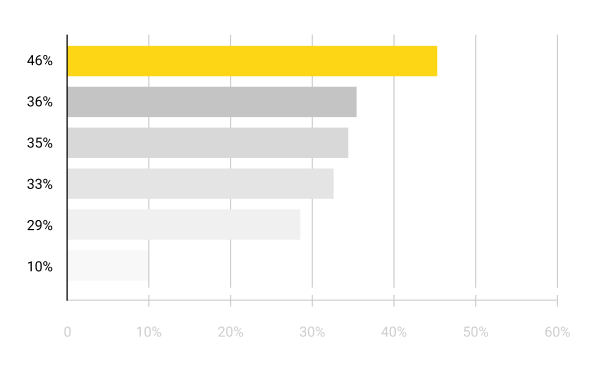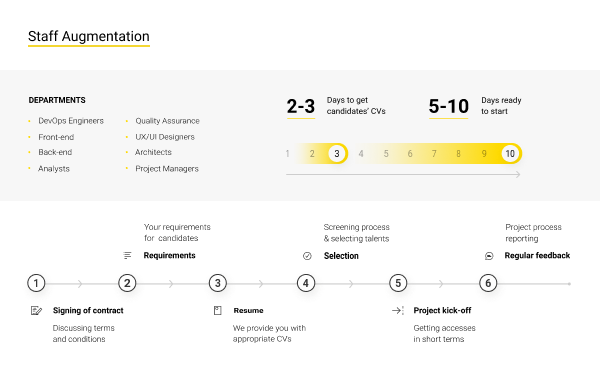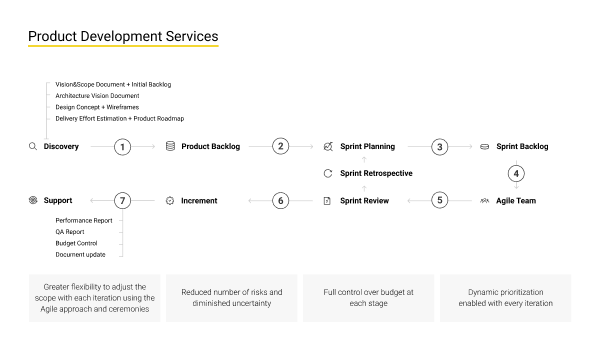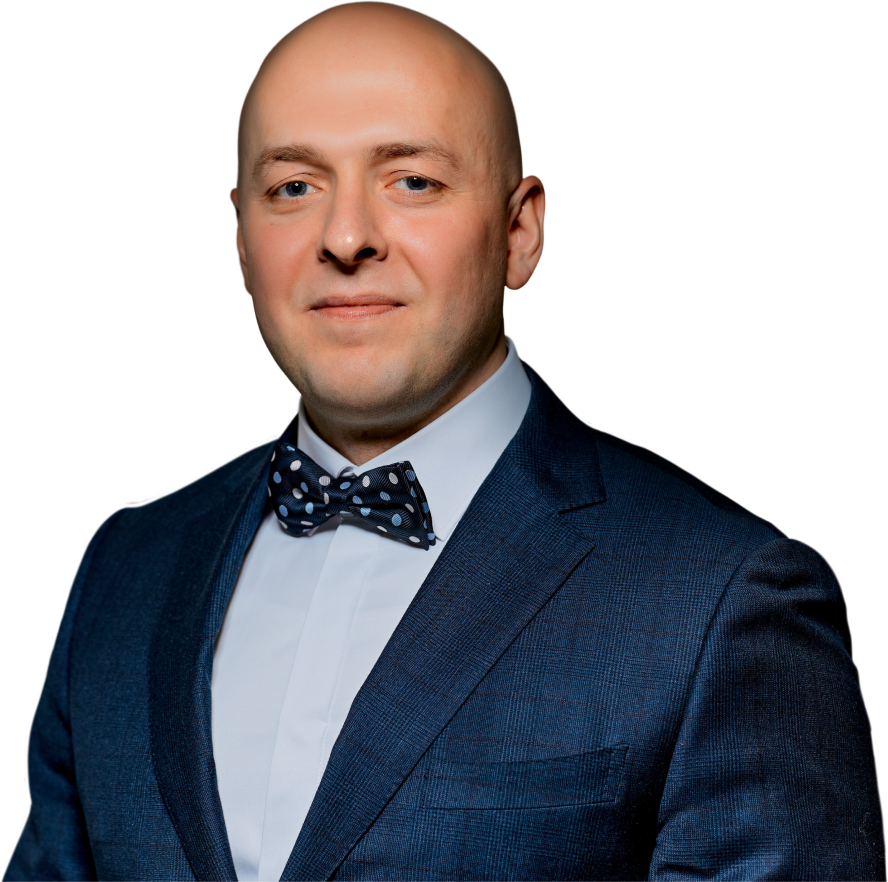- Overall background
- Andersen’s approaches to custom software development
- IT cooperation models: the details
- Conclusion
To begin with, allow us to say once again: with hundreds of complex IT projects delivered over more than a decade, we at Andersen know that each of our customers is unique. It can’t be otherwise, since we collaborate with companies of different sizes and across different industries. Our key to success is to be a truly Agile-based and flexible company both in letter and spirit. As such, we take different approaches to software development frameworks and processes. In this piece, we are going to briefly describe all of them, with a special emphasis on the most comprehensive - Andersen’s Software Product Development Services.
Overall background
Let’s start by highlighting the top reasons why companies outsource some of their IT projects and processes. According to Statista, the breakdown looked like this around 2019:

- 46% of companies just needed access to a source of software development and IT skills that their in-house IT teams lacked
- 36% were preoccupied with cutting costs and saving money
- 35% saw their main IT outsourcing objective as “freeing up resources” so that they could afford to “focus on core business”
- 33% intended to boost their effectiveness and “add scale” to their IT departments
- 29% wanted to optimize their ways of spending resources to make them more flexible
- Finally, 10% needed qualified IT assistance in advancing their “ability to innovate”
As you can see, all these concerns are complex. That’s to say, in almost all of these cases, the scope of work is not limited to simple tasks à la “just write these lines of code from here to there” or “simply make it work.” Quite the contrary, these priorities imply closer business and tech partnerships in more sophisticated forms.
Consequently, modern custom software development vendors nowadays cooperate with their customers on a more advanced basis. This framework exceeds the narrow “client-contractor” models focused on separate small-scale tasks. As a result, several approaches to software development cooperation formats have evolved across the IT industry.
By applying them, modern IT companies can help their heterogeneous customers from different industries resolve any feasible IT challenge and ensure the very IT project deliverables you require. At the same time, it's always up to the customer to choose the available approach.
Below, you can familiarize yourself with Andersen’s frameworks, learn more about their advantages and shortcomings, and decide for yourself what your preferences are.
Andersen’s approaches to custom software development
Basically, Andersen offers its customers the following three options:
- A dedicated IT team within the outstaffing model. Under this model, Andersen gives you convenient access to our human resources, i.e. simply hire coders and other IT specialists for a specific goal you are pursuing. As a result, the tasks you will assign to them, as well as the general IT project objective and other applicable details, will be defined solely by you. In other words, you will be expected to present explicit and precise guidelines for each coding sprint. Andersen’s outstaffed specialists, in turn, will be responsible for writing the code you need. It goes without saying that all code will be written and checked in strict compliance with the best industry practices.

-
Fixed price approach. Within this framework, Andersen’s customers normally have a well-thought-out idea of the software product they are planning to obtain in terms of its future tasks and tech properties. The outcome is that Andersen’s IT experts are able to estimate the future project workflow and the resources it requires. After that, they will develop an IT tool based on these estimates. However, as the project scope is fixed from the very beginning, it will be delivered as described, without unexpected improvements or add-ons that may occur to you in the process.
-
Finally, PDS - or Product Development Services, is the most adjustable, customizable, and iterative interaction model. This is because it is all about project-based collaborations aimed at building software products from scratch and attaining every possible business goal. In addition, the PDS framework is a perfect option to thoroughly “rewrite” and upgrade your already functioning IT solution in its entirety or across its separate parts. Therefore, Andersen’s IT experts will collaborate with your representatives throughout the entire process in a proactive and extremely responsive way. In a word, a PDS project is a comprehensive IT service at its best.

IT cooperation models: the details
Once again, there is a range of factors at play when you need to make your choice and opt for one of the above-mentioned models of collaboration between your organization and the IT vendor of software development services. They are as follows:
- The IT project scope of your initiative
- The IT project scope of your initiative
- The extent of your future involvement in the implementation process, both in tech and management terms
- Your projected spending
a. Outstaffed and dedicated IT teams
This approach can also be referred to as “body leasing” and “team augmentation”. This framework makes it possible to strengthen your in-house IT team by adding some extra members to it. Normally, such augmentation is based on project needs caused by a lack of skills, expertise, or experience: you simply obtain a group of qualified persons that will cover such gaps. Alternatively, augmentation can also be based on a period of time to compensate for prolonged sick leaves, maternity leaves, etc.
Benefits:
- Such a staffing model is, as a rule, the quickest and easiest one to launch. You have a list of criteria, your software services vendor has an IT talent pool with CVs. All you need to do is to “scan” this list and identify matches.
- At the same time, this model makes it possible for you to use resources in a more optimized fashion. First, you do not have to deal with time-consuming recruitment processes. Second, you allocate hiring costs for a limited period of time only, i.e. for the duration of your contract, not indefinitely.
- Finally, this model is extremely flexible. This flexibility encompasses all the crucial factors of any IT project, i.e. its scope, budget, and projected timelines.
Potential problems:
- You will still have to onboard the outstaffed newcomers. Therefore, you need to meet them with a clear list of project deliverables, acceptance criteria, and job requirements.
- If your IT initiative takes more than several months, this option becomes less cost-effective.
- Sometimes, it takes more than adding a couple of extra temporary co-workers to attain an ambitious goal. Even the best developers need some assistance provided by PMs, BAs, UI/UX experts to create outstanding products.
b. Andersen’s fixed price approach
This approach to custom software development goes deeper than a simple staff augmentation policy. It presupposes that you outsource an entire project to Andersen’s team of IT experts, with a detailed and fixed description. Thus, you will collaborate not with individual developers, but with a group of coders, QA specialists, PMs, UX/UI experts, etc. Simply put, you get exactly what you order, Andersen’s team will follow the documents provided to the letter. You give us your product documentation, we assess it, submit an estimate, and proceed with the development stage.
Benefits:
- Your IT services vendor of choice will assume greater responsibility for the outcomes of the project (especially in comparison with a range of simple tasks assigned to a dedicated team).
- You will get not individual deliverables based on a series of tasks, but a complete and coherent IT project that is based entirely on your instructions submitted at the beginning.
Potential problems:
- At the very beginning, you communicate your initial vision of the solution. It may not be as clear as necessary. As an outcome, the eventual project result may differ from your implicit expectations.
- Within this fixed-priced framework, you will control the IT project in general, but not every iteration and sprint. Hence, some potentially valuable insights might not be taken into full consideration.
c. Product development services: your direction for complex IT initiatives
Andersen’s PDS framework is best suited for those customers who need seamless iterations and extensive attention to every applicable detail. It implies that Andersen will assume 100% responsibility for matching every feasible idea you already have or may generate in the future. Here is how a typical PDS project is implemented with us.
- Project discovery phase: our team will prepare a reliable and solid base for your IT initiative, elaborate plans, and assess possible risks. As a result, you will obtain such valuable deliverables as Vision and Scope, User Story Map, Design Concept, Architecture Diagram, and Vision Doc.
- Development phase: Andersen’s software developers launch their Agile-based coding sprints. As Andersen practices Scrum-based policies, every sprint is extremely iterative to cover as many priorities as needed. Typically, the duration of a sprint is two weeks. At the same time, synching sessions are held every week. Needless to say, before each sprint starts, corresponding scopes and budgets are submitted and discussed when required.
- Knowledge transfer phase: Andersen’s key mission at this stage is to help you obtain full ownership of the IT project delivered. It encompasses not only its code base but also all the tech and business docs, user-guides, accesses, tutorials, etc.
- Support and development phase: Beyond any doubt, Andersen’s IT team will keep in touch with the customer after the knowledge transfer is accomplished. Our goal here is to make sure that the solution functions seamlessly and properly. Our team is also always ready to provide instant assistance when needed.
Conclusion
In today’s digitized and data-driven economy, being competitive in IT terms is a matter of survival. Consequently, to stay on top, you will inevitably have to adjust to the changing landscapes and client demands. Thus, the IT tools you offer to your target audience need to be best-in-class.
Simpler models of custom software services - augmented teams and fixed-price projects - are becoming less and less popular. While there are still cases in which they can be successfully applied, truly ambitious and far-reaching IT initiatives require more advanced models, such as Andersen’s product development services. If you're considering one right now, feel free to contact us to request a free consultation!




